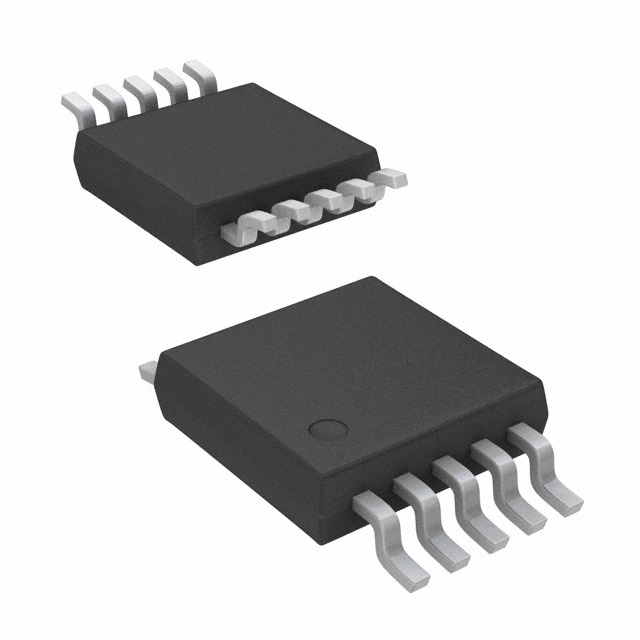AD5691RBRMZ-RL7
Product Overview
Category
The AD5691RBRMZ-RL7 belongs to the category of digital-to-analog converters (DACs).
Use
This product is primarily used in various applications where a high-resolution digital input needs to be converted into an analog output signal.
Characteristics
- High resolution: The AD5691RBRMZ-RL7 offers a resolution of up to 16 bits, allowing for precise analog output generation.
- Low power consumption: This DAC operates at low power levels, making it suitable for battery-powered devices.
- Small package size: The AD5691RBRMZ-RL7 comes in a compact package, enabling its use in space-constrained designs.
- Wide operating voltage range: It can operate within a wide voltage range, providing flexibility in different applications.
Package and Quantity
The AD5691RBRMZ-RL7 is available in a small 10-lead MSOP package. It is typically sold in reels, with a quantity of 2500 units per reel.
Specifications
- Resolution: Up to 16 bits
- Operating Voltage Range: 2.7V to 5.5V
- Output Voltage Range: 0V to VREF
- Reference Input Voltage Range: 2.5V to 5.5V
- Power Consumption: 0.4mW (typical)
- Temperature Range: -40°C to +105°C
Pin Configuration
The AD5691RBRMZ-RL7 has the following pin configuration:
```
| | | AD5691RBRMZ-RL7 | |_______________________________________| | | | 1 2 3 4 5 6 7 8 9 10| |_______________________________________|
Pin 1: VOUT Pin 2: GND Pin 3: SDA Pin 4: SCL Pin 5: VLOGIC Pin 6: VDD Pin 7: A0 Pin 8: A1 Pin 9: A2 Pin 10: REF ```
Functional Features
- High-resolution digital-to-analog conversion
- I2C-compatible interface for easy integration with microcontrollers
- Power-on reset function ensures reliable startup behavior
- Internal reference voltage generator for simplified design
- Software programmable output range and power-down modes
Advantages and Disadvantages
Advantages
- High resolution allows for precise analog output generation.
- Low power consumption makes it suitable for battery-powered devices.
- Compact package size enables use in space-constrained designs.
- Wide operating voltage range provides flexibility in different applications.
Disadvantages
- Limited output voltage range compared to some other DACs on the market.
- Requires an external reference voltage source.
Working Principles
The AD5691RBRMZ-RL7 operates by converting a digital input code into an analog output voltage. It utilizes an internal digital-to-analog conversion technique, which accurately translates the digital input value into a corresponding analog voltage level. This analog output can then be used as a control signal or as part of a feedback loop in various applications.
Detailed Application Field Plans
The AD5691RBRMZ-RL7 finds applications in a wide range of fields, including: - Industrial automation and control systems - Test and measurement equipment - Audio and video processing - Programmable logic controllers (PLCs) - Data acquisition systems - Medical devices - Automotive electronics
Alternative Models
Here are some alternative models that offer similar functionality to the AD5691RBRMZ-RL7: - AD5689R: 16-bit DAC with similar features and package options. - AD5669: 16-bit DAC with a different package and interface options. - MCP4922: 12-bit DAC with SPI interface and different package options.
These alternative models can be considered based on specific application requirements and design constraints.
In conclusion, the AD5691RBRMZ-RL7 is a high-resolution digital-to-analog converter that offers precise analog output generation. Its compact size, low power consumption, and wide operating voltage range make it suitable for various applications in different fields. However, it has some limitations, such as a limited output voltage range and the need for an external reference voltage source. Designers can also consider alternative models based on their specific needs.
Lista 10 Vanliga frågor och svar relaterade till tillämpningen av AD5691RBRMZ-RL7 i tekniska lösningar
Sure! Here are 10 common questions and answers related to the application of AD5691RBRMZ-RL7 in technical solutions:
Q1: What is the AD5691RBRMZ-RL7? A1: The AD5691RBRMZ-RL7 is a digital-to-analog converter (DAC) IC manufactured by Analog Devices.
Q2: What is the resolution of the AD5691RBRMZ-RL7? A2: The AD5691RBRMZ-RL7 has a resolution of 16 bits, allowing for high precision analog output.
Q3: What is the supply voltage range for the AD5691RBRMZ-RL7? A3: The AD5691RBRMZ-RL7 operates with a supply voltage range of 2.7V to 5.5V.
Q4: How many channels does the AD5691RBRMZ-RL7 have? A4: The AD5691RBRMZ-RL7 has a single channel, meaning it can output analog signals on one channel only.
Q5: What is the interface used to communicate with the AD5691RBRMZ-RL7? A5: The AD5691RBRMZ-RL7 uses an I2C interface for communication with a microcontroller or other devices.
Q6: Can the AD5691RBRMZ-RL7 be used in both industrial and consumer applications? A6: Yes, the AD5691RBRMZ-RL7 is suitable for use in both industrial and consumer applications due to its wide operating temperature range and low power consumption.
Q7: Does the AD5691RBRMZ-RL7 have any built-in reference voltage? A7: No, the AD5691RBRMZ-RL7 requires an external reference voltage for accurate analog output.
Q8: What is the settling time of the AD5691RBRMZ-RL7? A8: The settling time of the AD5691RBRMZ-RL7 is typically 10 μs, ensuring fast and accurate output response.
Q9: Can the AD5691RBRMZ-RL7 be used in battery-powered applications? A9: Yes, the low power consumption of the AD5691RBRMZ-RL7 makes it suitable for battery-powered applications.
Q10: Are there any evaluation boards or development kits available for the AD5691RBRMZ-RL7? A10: Yes, Analog Devices provides evaluation boards and development kits that can be used to easily test and integrate the AD5691RBRMZ-RL7 into a design.
Please note that these answers are general and may vary depending on specific application requirements.


